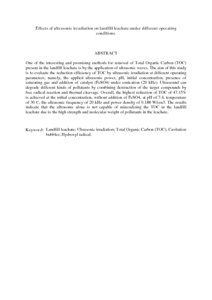Citation
Chua, Sze Yee and Abdul Latif, Puziah and Ibrahim, Shaharin
(2010)
Effects of ultrasonic irradiation on landfill leachate under different operating conditions.
The IUP Journal of Environmental Sciences, 4 (1).
pp. 32-40.
ISSN 0973-9912
Abstract
One of the interesting and promising methods for removal of Total Organic Carbon (TOC) present in the landfill leachate is by the application of ultrasonic waves. The aim of this study is to evaluate the reduction efficiency of TOC by ultrasonic irradiation at different operating parameters, namely, the applied ultrasonic power, pH, initial concentration, presence of saturating gas and addition of catalyst (FeSO4) under sonication (20 kHz). Ultrasound can degrade different kinds of pollutants by combining destruction of the target compounds by free radical reaction and thermal cleavage. Overall, the highest reduction of TOC of 47.15% is achieved at the initial concentration, without addition of FeSO4, at pH of 7.4, temperature of 30 C, the ultrasonic frequency of 20 kHz and power density of 0.188 W/cm3. The results indicate that the ultrasonic alone is not capable of mineralizing the TOC in the landfill leachate due to the high strength and molecular weight of pollutants in the leachate.
Download File
![[img]](http://psasir.upm.edu.my/14425/1.hassmallThumbnailVersion/Effects%20of%20ultrasonic%20irradiation%20on%20landfill%20leachate%20under%20different%20operating%20conditions.pdf)  Preview |
|
PDF (Abstract)
Effects of ultrasonic irradiation on landfill leachate under different operating conditions.pdf
Download (83kB)
| Preview
|
|
Additional Metadata
Actions (login required)
 |
View Item |

